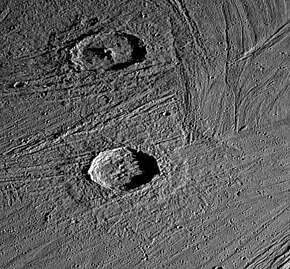 The crater to the south is Achelous | |
| Feature type | Crater |
|---|---|
| Coordinates | 61°48′N 11°42′W / 61.8°N 11.7°W |
| Diameter | 40.0 kilometres (24.9 mi) |
| Eponym | Achelous |
Achelous is a relatively fresh crater on Ganymede adjacent to the similarly sized Gula. It was found on April 5, 1997 by the Galileo Spacecraft. It has an outer lobate ejecta deposit which extends with a radius of about a crater from the rim[1]
The two craters, similar in size have a "pedestal", an outward-facing, sloped scarp that ends the continuous ejecta blanket. In ejecta blankets of Martian craters, similar features are seen, suggesting impacts into a volatile and rich material. The craters appear to be crisp and feature terraces. For Gula, a prominent central peak is visible, but Achelous may show the remains of a collapsed peak or a central pit that is not fully formed. Lower-resolution images taken under higher sun illumination showed that both craters have extended bright rays, especially Achelous, which demonstrates that these craters are relatively younger than the rest of the landscape.[2]
- ^ "Fresh Impact Craters on Ganymede". Jet Propulsion Laboratory. 1997-04-05. Retrieved 2024-09-05.
- ^ "Pedestal Craters Gula and Achelous on Ganymede". NASA Jet Propulsion Laboratory (JPL). Retrieved 2024-09-05.